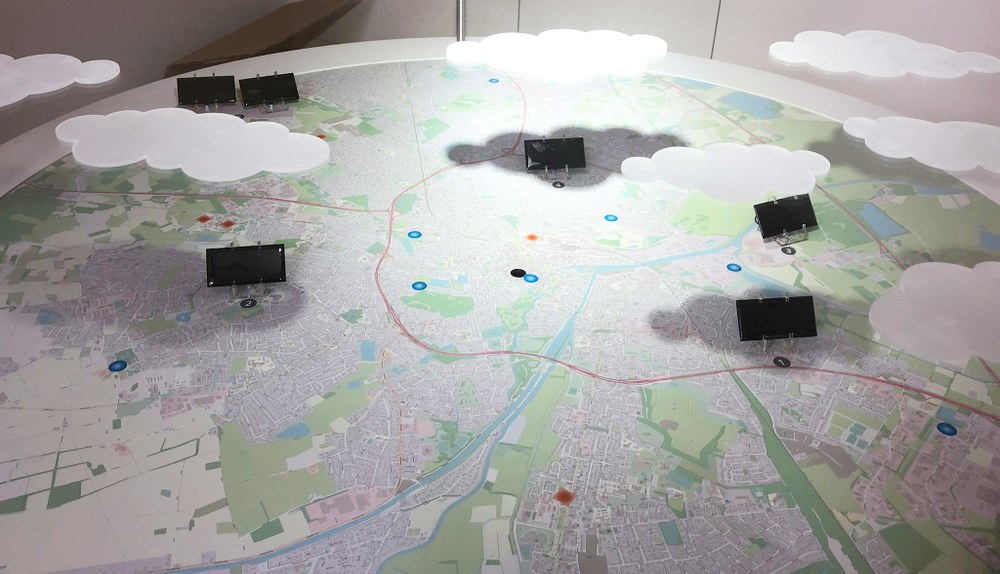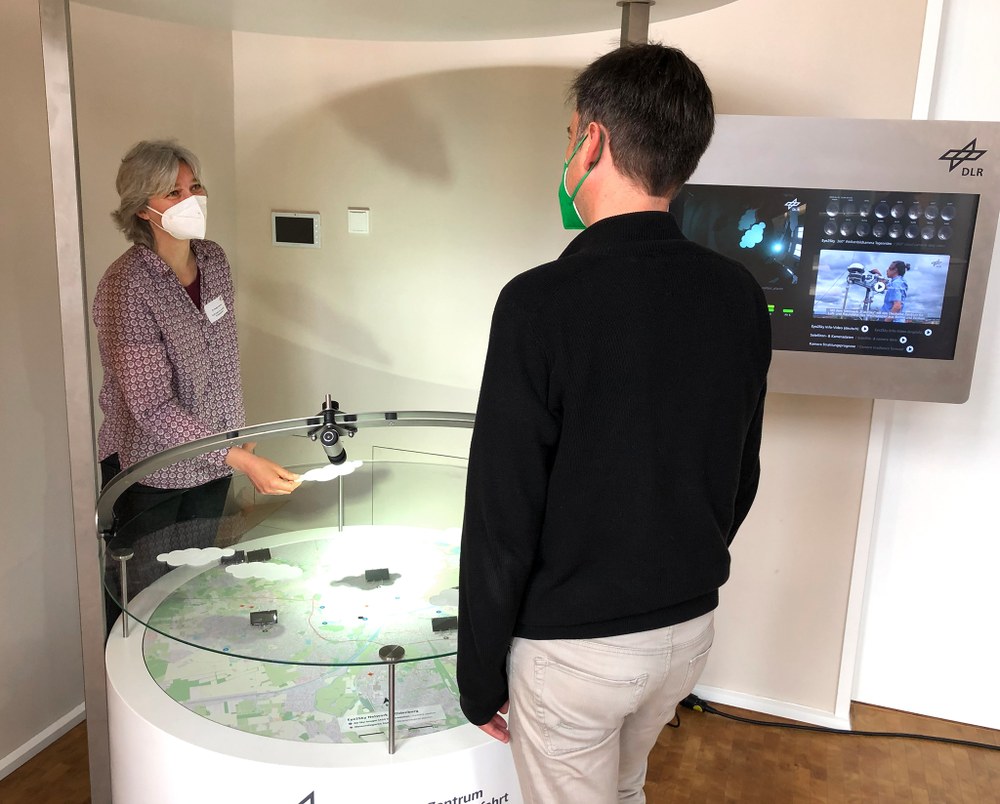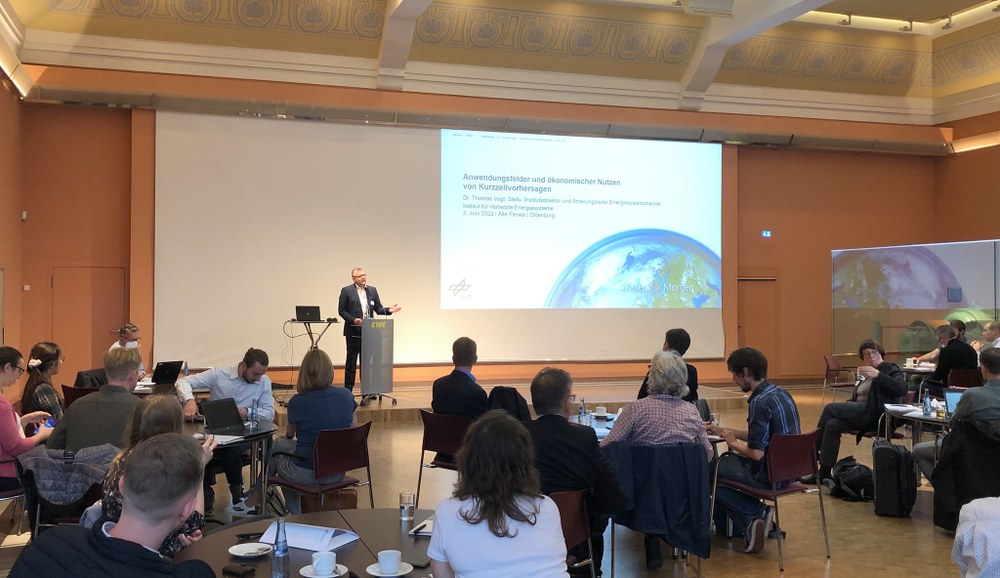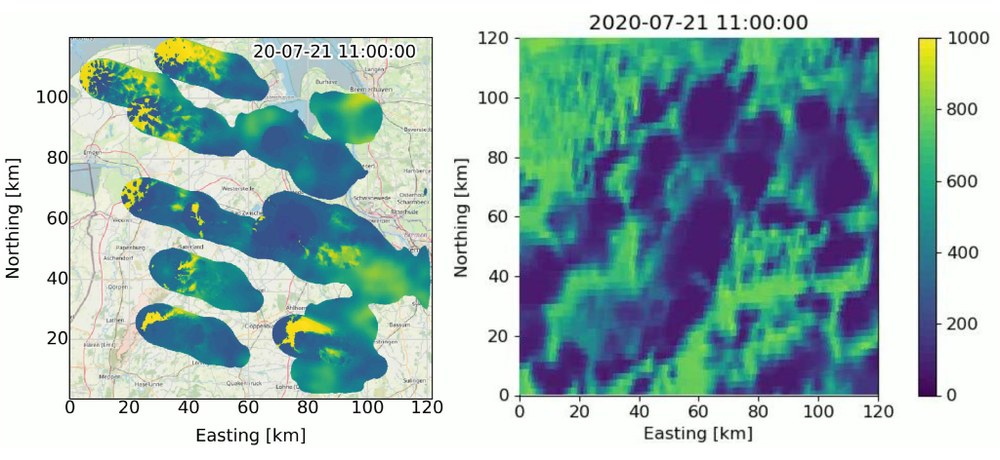Energy market players set their sights on Eye2Sky measuring network

- DLR hosted the workshop "Fields of application and economic benefits of short-term forecasts" in Oldenburg on 2 June 2022.
- Around 40 guests, including system and grid operators, energy traders, forecasting providers and researchers, took part in the event.
- The discussions focussed on the innovative "Eye2Sky" measurement network, which DLR has developed and installed in north-west Germany.
- Focus: Energy, energy meteorology
DLR workshop on short-term meteorological forecasts opens up new perspectives for fields of application and business models.
What is the significance of precise solar power forecasts for future energy systems? How can PV yield data with high spatial and temporal resolution be used profitably for electricity trading and distribution grid operators? - The German Aerospace Center (DLR) brought together representatives from research, services, business and energy trading on this topic for the first time at the workshop "Fields of application and economic benefits of short-term forecasts" on 2 June 2022 in Oldenburg, Lower Saxony. The discussions focused on the innovative "Eye2Sky" measurement network, which DLR has developed and installed in north-west Germany. It provides unique forecast data on solar radiation and cloud cover and is now to be gradually adapted to the needs of the energy market.

The need for improved forecasting capabilities is obvious, as the future electricity supply will be based almost entirely on renewable energies. A large proportion of this will be fed in directly from countless decentralised PV systems. "This means that every cloud field has a direct influence on our power grid," explains Dr Annette Hammer, co-organiser from the Energy Meteorology research group at the DLR Institute of Networked Energy Systems. "For example, fleecy clouds cause locally high fluctuations in solar power production. The smaller the area under consideration and the shorter the time scale, the more massive the effect on the distribution grid. Precise forecasts of these fluctuations are therefore particularly relevant, but are also the most difficult to generate.
DLR researchers have developed the Eye2Sky measurement network with the aim of being able to make corresponding short-term forecasts for the energy market. It currently consists of 39 measurement sites covering an area of 110 by 100 kilometres between the North Sea, the Dutch border and Oldenburg. Instruments for measuring solar radiation are located at twelve of these sites. The centrepiece of each individual station, however, is a cloud camera that transmits a 360-degree image "from horizon to horizon" to a DLR high-performance computer every 30 seconds. Any spatial gaps are compensated for by satellite data.

This immense amount of data from images and ground measurements is translated into real-time and forecast values for solar radiation using the WOBAS model, which was developed at the DLR Institute of Solar Research in Almería. The algorithm is able to recognise the clouds, their movement vectors and their optical properties. This enables the research team to not only track every cloud from the North Sea to Oldenburg, but also their height with the help of ceilometres. "This is crucial, as it is not the cloud itself that influences the PV yield, but the shadows it casts," explains Hammer. Eye2Sky is therefore able to predict high-resolution spatial and temporal values of solar radiation up to 30 minutes into the future.
Scientifically, Eye2Sky is a technological highlight. The comparison with the economic interests of the electricity market players at the workshop made one thing clear above all: agreement on the assumption that short-term forecasts will be an elementary component of the energy market in the future. Eye2Sky data could be used to improve grid monitoring and make a valuable contribution to reducing curtailments. Grid operators could organise the upcoming grid expansion more efficiently - and therefore more cost-effectively. On the electricity market, intraday trading would open up the prospect of reducing the time interval before delivery from 15 to six to seven minutes. And system owners would have the option of specifically increasing their own consumption.

However, concrete answers, such as the level of detail of the data or organisational structures, will have to be specified in future projects and working groups. For example, there are suggestions that the stationary measurement network installed for research purposes to date should be given a more flexible structure. For example, direct marketers could position mobile cameras or stations variably at the locations of their respective contractual partners. Another conceivable business model would be for system operators to install the cloud cameras themselves and have their data shared and analysed by a forecasting service provider. The result would be an increasingly comprehensive network of solar park operators in the style of swarm intelligence.
By discussing these and other interdisciplinary suggestions, the organisation team of the workshop achieved its main goal: "We wanted to learn directly from the players in the energy sector what concrete benefits they expect for predictions in their specific application. At the same time, we presented what is possible from a scientific and technical perspective," says Hammer, summarising her impressions of the event. "We have thus laid the foundation for new collaborations to make short-term forecasts an integral part of the future energy market."
